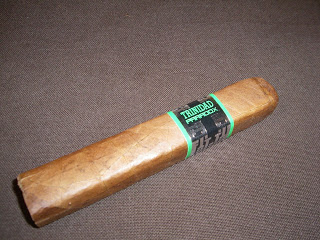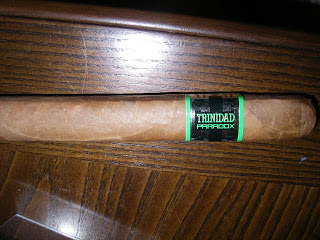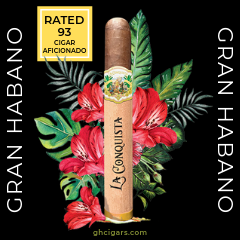 |
| Trinidad Paradox – Robusto |
At the 2012 IPCPR Trade Show in Orlando, Florida, launched a new addition to its Trinidad brand, the Trinidad Paradox. Like many of the other 2012 Altadis releases, there has been an underlying theme with Altadis in 2012 and that has been to reconnect with their consumer base by reinvigorating their existing brands. The Trinidad Paradox was one of four 2012 release blends by Altadis to leverage a non-maduro Mexican wrapper (the other three being the VegaFina Jose Seijas 2011 , the VegaFina Fortaleza 2, and the Te-Amo Revolution). I recently had an opportunity to sample the Trinidad Paradox. I found this to be a fine addition to the Trinidad line. This adds another solid release to what has been a very good year for Altadis.
When I assessed the recent Te-Amo Revolution, I wrote the following on Atladis’ use of Mexican tobacco:
Altadis’ leverages much of its Mexican tobacco from the Turrent family. The company has made several releases with Mexican wrapper cigars over the past few years… While we have seen a large increase in Mexican wrapper cigars in the marketplace, much of this has been focused in the area of maduro wrappers – most prominently the San Andres Negro wrapper. With the recent Altadis releases, we have seen the use of Mexican tobacco go wider – with San Andres Criollo (VegaFina Jose Seijas 2011, VegaFina Fortaleza 2, Trinidad Paradox), San Andres Corojo (A.Turrent Puro Corojo), and…with the the Te-Amo Revolution a San Andres Habano.
I have particularly found the San Andres Criollo to be a hidden gem in the Altadis portfolio as it has delivered some very flavorful cigars. I think this wrapper plays a key role in producing great flavors by the Trinidad Paradox.
Let’s take a closer look at the Trinidad Paradox and see what this cigar delivers:
Blend Profile
In addition to utilizing San Andres Criollo from Mexico, the blend features a Dominican binder, and Nicaraguan filler.
Blend: San Andres Criollo 98
Binder: Dominican Piloto
Filler: Nicaraguan
Vitolas Available
The Trinidad Paradox is a box-pressed cigar currently available in four sizes. The cigars are packaged 16 cigars per box.
Robusto: 5 x 54
Toro: 6 x 54
Belicoso: 6 1/8 x 52
Churchill: 7 x 57
 |
| Trinidad Paradox – Toro |
Appearance
For this cigar experience, I sampled the robusto vitola of the Trindad Paradox. The wrapper has a medium-brown color to it. The box-press shape helps the wrapper take on a silky look to it. There are some visible veins, but the wrapper seams are well hidden (although on the toro vitola, they were more noticeable). As for the box-press itself, it has a nice firm pack to it.
The band features a very contemporary design. This is a radical departure from the simpler gold and black bands that are featured across the Trinidad line. The color scheme is kelly green, silver, and black. The design of the band is in a landscape (sideways) mode and features a black background with kelly green stripes on the left and right side. The “TRINIDAD” name is in kelly green font. Just under it is the text “PARADOX” in a smaller kelly green font. There is also a pattern of silver “T”s in a wallpaper mode on the band.
Preparation for the Cigar Experience
For my smoke of the Trinidad Paradox Robusto, I went with a straight cut into the square-press shaped cap. Once the cap was successfully removed, it was time for the pre-light draw experience. The dry draw wasn’t terribly exciting or bold. For the most part, I detected flavors of wood, but also picked up some mild notes of natural tobacco sweetness and pepper spice. While this pre-light draw did not have me doing handstands, we do not score the pre-light draw in our assessment rating and score – so no loss of points here. It was now time to light the Trinidad Paradox and see what the cigar experience would bring to the table.
Flavor Profile
The Trinidad Paradox isn’t a cigar that is going to bring about a lot of flavor transitions, however this is a cigar that is going to deliver very good flavor.
Once lit, I detected some pepper on the classic black pepper. Once the pepper subsided, it gave way to a honey sweetness in the forefront while the pepper notes became more secondary. I also detected some natural tobacco flavor in the background. As the smoking experience progressed through the first half, the pepper notes remained secondary on the main draw, but could be better detected on the after-draw.
As the smoke of the Trinidad Paradox moved into the second half, the honey notes remained primary. The pepper notes were still secondary, and the natural tobacco notes were tertiary. The second half saw the pepper notes take on an increased presence. In the end, it was the honey notes that still were the main story as they were present right until the nub. The nub was cool in temperature and firm to the touch. In addition, the nub itself was a real finger-burner.
Burn and Draw
The Trinidad Paradox scored very well in the area of burn. For the most part, the burn line of the Paradox did not require a lot of maintenance to burn straight – only an occasional touch-up here and there. The resulting ash was a solid, white-colored one with only some minor flaking. The burn rate and burn temperature were ideal.
The draw was a little less than ideal to start with the Paradox. I found it to be tight on the onset of the smoke. The draw did seem to open up by the middle of the first third, and following that point it did not become an issue.
Strength and Body
Altadis USA’s Trinidad line is well-known for making “fuller” smokes in terms of body and strength. From a strength perspective, I would say the Trinidad Paradox is a more amp’d down cigar in this line. It still has enough of a nicotine kick to be considered medium strength. The body of the Trinidad Paradox was very interesting. I found the robusto vitola to have the most flavor depth, and can say it fits in with the Trinidad line from a body standpoint. I found the Trinidad Paradox Robusto to have enough depth in its flavors to be full-bodied. I would not say this for the Toro or Bellicoso as these vitolas seemed to be more medium to full-bodied. In the case of the Trinidad Paradox, the body definitely has an edge over the strength.
Final Thoughts
As I mentioned at the start of this assessment, I like what Altadis is doing with the use of non-maduro San Andres wrappers. The use of the San Andres Criollo on the Trinidad Paradox works real nicely with this blend. This once again delivers another solid cigar into Altadis’ portfolio. I also liked how this blend worked as a box-press. The only negative was that it was void of a lot of flavor transitions, but it did provide some nice flavors. This is definitely a cigar I would recommend to a novice cigar enthusiast looking for a medium strength smoke with a nice amount of flavor. Experienced cigar enthusiasts will like this cigar as well for the flavor it produces. As for myself, I enjoyed this cigar – particularly the robusto. This is a cigar I will be smoking again.
Summary
Burn: Excellent
Draw: Good
Complexity: Low
Strength: Medium
Body: Full
Finish: Excellent
Assessment: Nice to Have
Score: 90
Source: The cigars for this assessment were purchased from Outland Cigars in Charlotte, North Carolina.





The Scoop With Coop – KMA Talk Radio
September 18, 2017 @ 1:05 pm
[…] the Trinidad Santiago is the first regular production release since 2012’s Trinidad Paradox. Since then there was a limited edition cigar under Trinidad called Trinidad Lost Blends that was […]